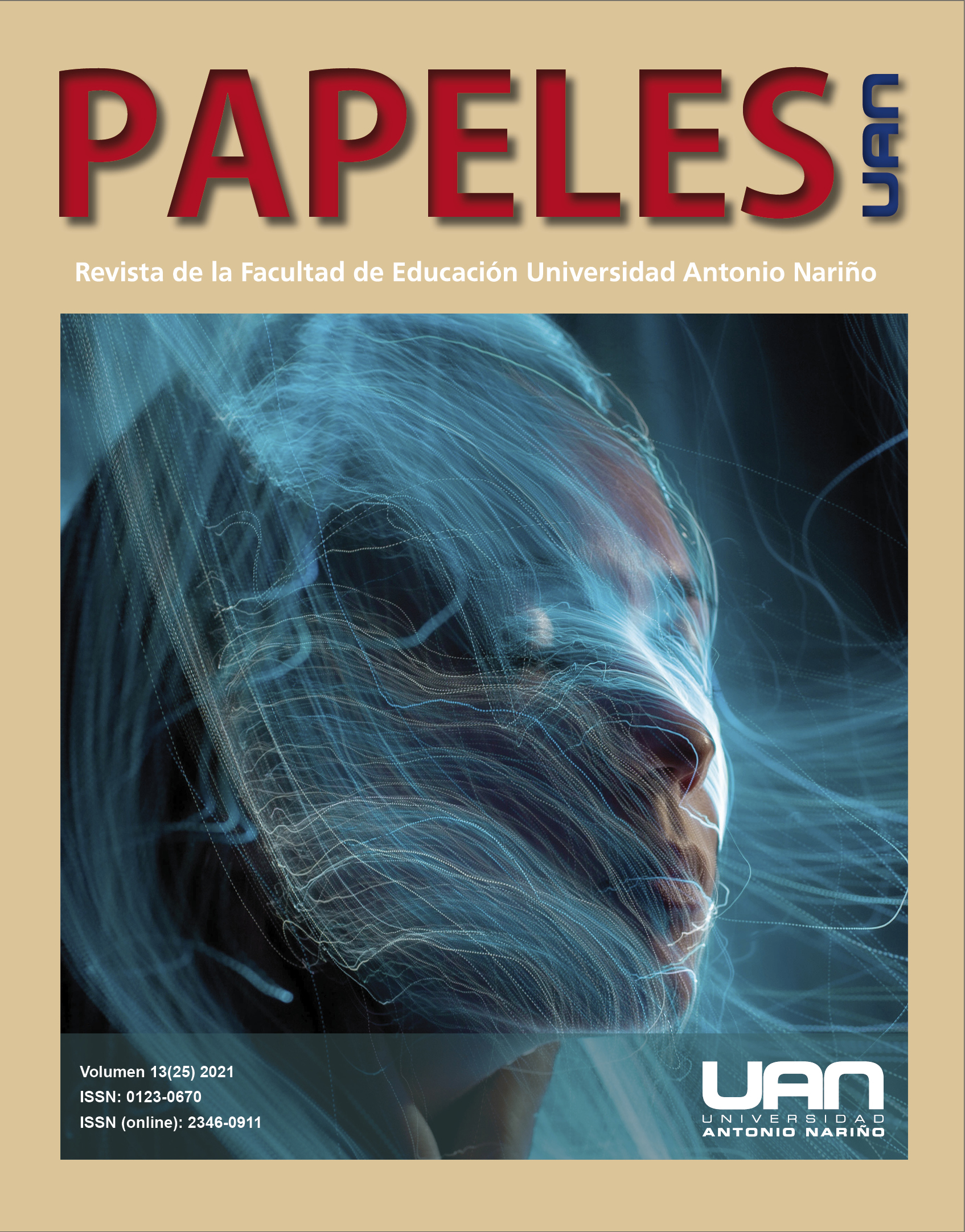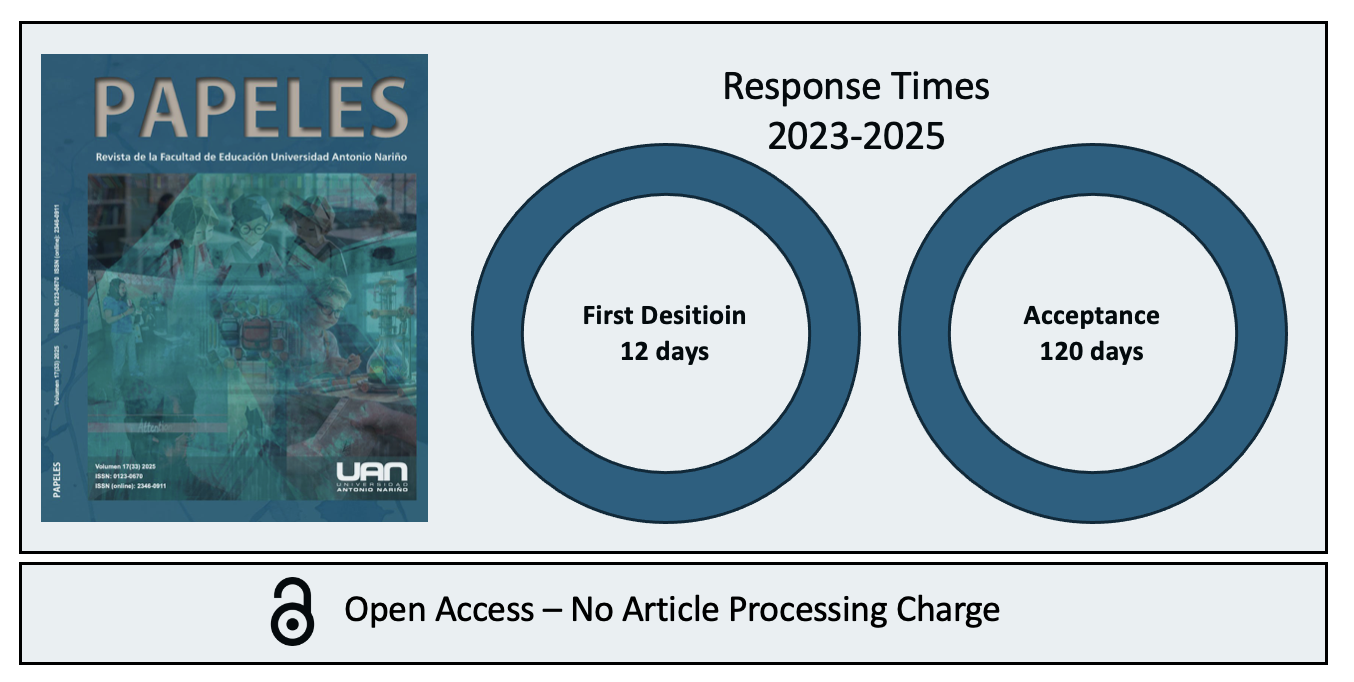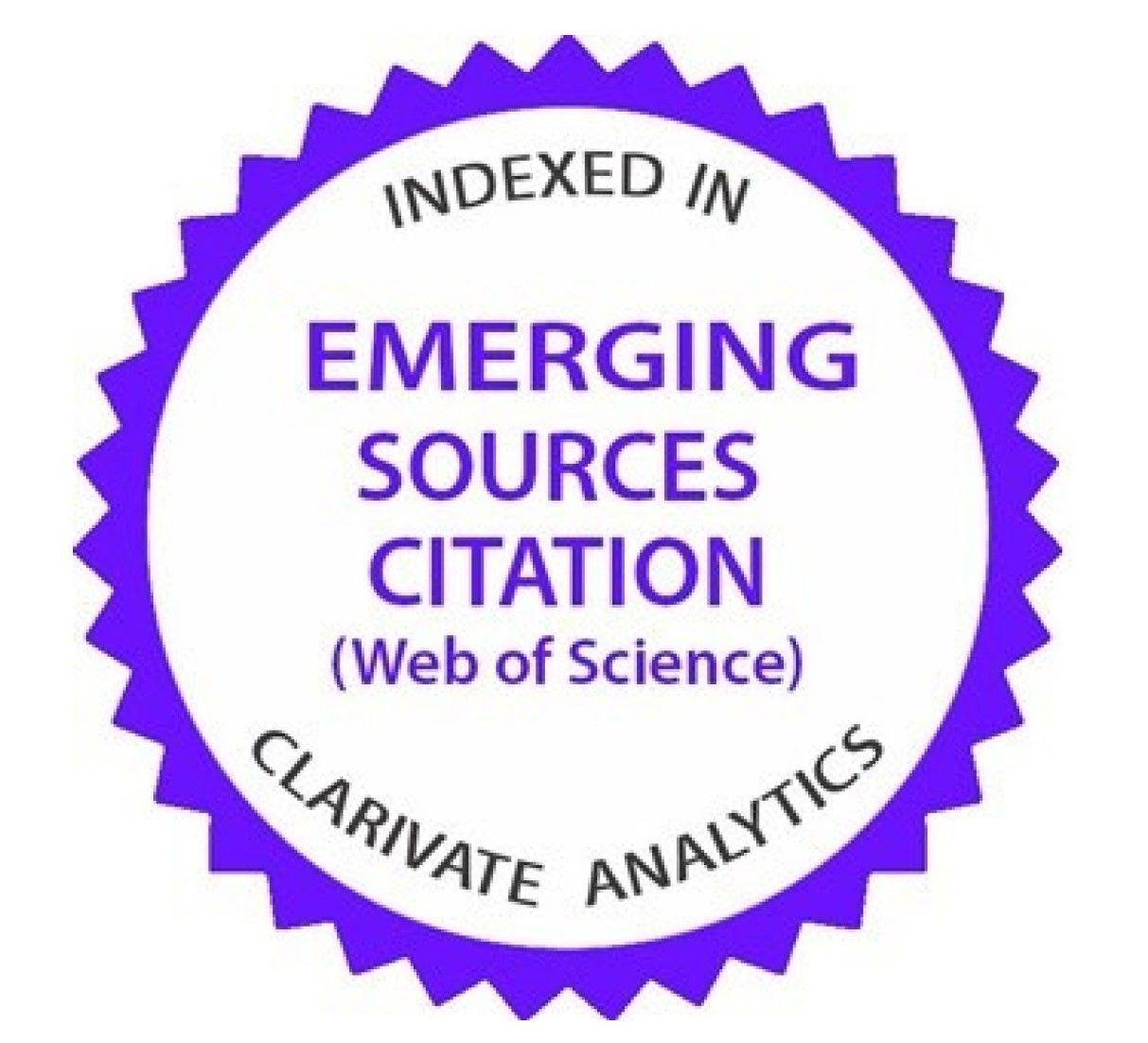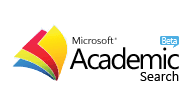Didactic incorporation of ICT to chemistry teaching: strengthen of digital skills in pandemic times
Incorporación Didáctica de recursos TIC a la Enseñanza de la Química: fortalecimiento de habilidades digitales en tiempos de pandemia
DOI:
https://doi.org/10.54104/papeles.v13n25.934Keywords:
ICT in education, didactic of chemistry, educative informatic, cognitive skills, linguistic skillsAbstract
Part of the results of a classroom experience that takes theoretical foundations from a proposal for ICT incorporation are presented, under a model of development of cognitive linguistic skills, through the teaching of structuring concepts of chemistry. As a practical exercise of intervention in the classroom, this work proposed to apply a methodology of "Didactic Design with ICT Incorporation", with the aim of achieving better learning in students, offering alternative scenarios of scientific-scholar education in the non-face-to-face modality, caused by the health crisis of COVID-19. Taking methodological aspects of the action-research, instruments were developed to understand the emerging needs of ICT incorporation, due to the withdrawal of the school population from the classrooms, participant intervention was carried out to address the difficulties of the proposed methodology and achieve efficient solutions. Among the findings the need to promote training processes in ICT for teachers, to face educational technological challenges, generate digital skills in students of public institutions in the city of Bogotá and recognize alternative didactic design approaches that allow to overcome specific problems of science education mediated by ICT.
Downloads
References
Abella-Peña, L. (2012). Con Ciencias en el Quiroga Alianza, red virtual para el aprendizaje de las ciencias experimentales. In Redes escolares en el territorio de derechos. Redes escolares Localidad Rafael Uribe Uribe (pp. 57–66). IDEP- Instituto para la Investigación educativa y desarrollo pedagógico.
Abella-Peña, L. (2019). La inclusión de recursos digitales para la enseñanza de la Química. Qué se ha hecho y qué falta por hacer - Un estado del arte. En Quintanilla M. y Vauras M. (Eds.), Inclusión Digital y Enseñanza de las Ciencias Aprendizaje de competencias del futuro para promover el desarrollo del Pensamiento Científico (pp. 147–167). Bellaterra, Sociedad Chilena de Didáctica, Historia y Filosofía de las Ciencias. http://laboratoriogrecia.cl/?page_id=149&did=188
Abella-Peña, L., Bonilla, M., Calderón, D., Correal, M., Gil, D., García-Martínez, Á., Hernández, R., León, O., Medina, G., Molina, A., Mosquera Suárez, C. J., Romero, J., Prieto, C. Y., Soler, S., & Guevara, J. C. (2013). Orientaciones específicas para la integración de tic en la enseñanza de las ciencias naturales (C. Merino Rubilar & M. Borja Orozco, Eds.). Ediciones Universitarias de Valparaíso. https://www.senadis.gob.cl/descarga/i/993/documento
Achuthan, K., Kolil, V. K., & Diwakar, S. (2018). Using virtual laboratories in chemistry classrooms as interactive tools towards modifying alternate conceptions in molecular symmetry. Education and Information Technologies, 23(6), 2499–2515. https://doi.org/10.1007/s10639-018-9727-1
Aguirre-García, J. C., & Jaramillo-Echeverri, L. G. (2008). Consideraciones acerca de la investigación en el aula: más allá de estar a la moda. Educ.Educ, 11(1), 43–54.
Arias Gil, V. (2016). Las TIC en la educación en ciencias en Colombia una mirada a la investigación en la línea en términos de su contribución a los propósitos actuales de la educación científica. In Universidad de Antioquía. http://hdl.handle.net/10495/5238
Barreto Leite, A. C., & Barreto Leite, M. A. (2013). Implantación de las tic en la materia química inorgánica. Enseñanza de Las Ciencias. Revista de Investigación y Experiencias Didácticas, 31(2), 253–268. https://doi.org/10.5565/rev/ec/v31n2.702
Blonder, R., Jonatan, M., Bar-Dov, Z., Benny, N., Rap, S., & Sakhnini, S. (2013). Can You Tube it? Providing chemistry teachers with technological tools and enhancing their self-efficacy beliefs. Chemistry Education Research and Practice, 14(3), 269–285. https://doi.org/10.1039/c3rp00001j
Bolaños, J. C. G., Martínez, A. G., Aguilar, C. S. C., & Sánchez, A. (2006). Computer-based Didactic Unit based on a simulator for the process of simple and fractioned distillation in the context of the education learning of Chemistry – UDQuim. World Conference on Educational Multimedia, Hypermedia and Telecommunications, 17–22.
Candela, A., Rockwell, E., & Coll, C. (2009). ¿Qué demonios pasa en las aulas? La investigación cualitativa del aula. CPU-e, Revista de Investigación Educativa, 8(enero-junio), 1–28. http://www.redalyc.org/articulo.oa?id=283121717001
Cataldi, Z., Chiarenza, D., Dominighini, C., Donnamaría, C., & Lage, F. J. (2010). TICs en la enseñanza de la química. Propuesta para selección del Laboratorio Virtual de Química (LVQ). XII Workshop de Investigadores En Ciencias de La Computación, 720–724.
Chandra, S., & Sharma, B. (2018). Near, Far, Wherever You Are: Chemistry via Distance in the South Seas. American Journal of Distance Education, 32(2), 80–95. https://doi.org/10.1080/08923647.2018.1440106
Coca, D. M. (2015). Estudio de las motivaciones de los estudiantes de secundaria de física y química y la influencia de las metodologías de enseñanza en su interés. Educación XX1, 18(2), 215–235. https://doi.org/10.5944/educXX1.14016
Colmenares, A. M. (2012). Investigación-acción participativa: una metodología integradora del conocimiento y la acción. Voces y Silencios: Revista Latinoamericana de Educación, 3(1), 102–115. https://doi.org/10.18175/vys3.1.2012.07
Crandall, P. G., Engler, R. K., Beck, D. E., Killian, S. A., O’Bryan, C. A., Jarvis, N., & Clausen, E. (2015). Development of an augmented reality game to teach abstract concepts in food chemistry. Journal of Food Science Education, 14(1), 18–23. https://doi.org/10.1111/1541-4329.12048
Daza Pérez, E. P., Gras-Marti, A., Gras-Velázquez, À., Guevara, N. G., Togasi, A. G., Joyce, A., Mora-Torres, E., Pedraza, Y., Ripoll, E., & Santos, J. (2009). Experiencias de enseñanza de la química con el apoyo de las TIC. Educación Química, 20(3), 320–329. https://doi.org/10.1016/S0187-893X(18)30032-6
Dori, Y. J., Rodrigues, S., & Schanze, S. (2013). How to promote chemistry learning through the use of ict. In Teaching Chemistry – A Studybook (pp. 213–244). SensePublishers. https://doi.org/DOI: 10.1007/978-94-6209-140-5_8
Elboj, S., Esther, O., & Pérez, C. (2003). Learning Communities: A model of education in the Knowledge Society. Revista Interuniversitaria de Formación Del Profesorado, 17(3), 91–103. http://www.redalyc.org/pdf/274/27417306.pdf
Dori, Y. J., Rodrigues, S., & Schanze, S. (2013). How to promote chemistry learning through the use of ict. In Teaching Chemistry – A Study book (pp. 213–244). Sense Publishers. https://doi.org/10.1007/978-94-6209-140-5_8
Erduran, S., Simon, S., & Osborne, J. (2004). TAPping into argumentation: Developments in the application of Toulmin’s Argument Pattern for studying science discourse. Science Education, 88(6), 915–933. https://doi.org/10.1002/sce.20012
Erhel, S., & Jamet, E. (2013). Digital game-based learning: Impact of instructions and feedback on motivation and learning effectiveness. Computers & Education, 67(1), 156–167. https://doi.org/10.1016/j.compedu.2013.02.019
Frías, M. V., Arce, C., y Flores-Morales, P. (2016). Uso de la plataforma socrative.com para alumnos de Química General. Educación Química, 27(1), 59–66. https://doi.org/10.1016/j.eq.2015.09.003
García Martínez, A., Flores López, M. L., Merino Rubilar, C., Rodríguez Pineda, D. P., Hernández Barbosa, R., Reyes Cárdenas, F. de M., Abella-Peña, L., y Guevara Bolaños, J. C. (2014). La formación del profesorado de ciencias en contextos de diversidad una mirada desde la mediación con las TIC y la construcción de diseños didácticos. https://die.udistrital.edu.co/sites/default/files/doctorado_ud/publicaciones/la_formacion_de_profesores_de_ciencias_a_traves_del_diseno_curricular_mediado_por_las_tic.pdf
García-Martínez, Á., Hernández, R., y Abella-Peña, L. (2018). Diseño del trabajo de aula: un proceso fundamental hacia la profesionalización de la acción docente. Revista Científica, 33(3), 316–331. https://doi.org/https://doi.org/10.14483/23448350.12623
García-Martínez, Á., y Pinilla, J. (2007). Cuadernos de Currículo Colegios Públicos de excelencia para Bogotá Orientaciones curriculares para el campo de Ciencia y Tecnología. Secretaría de Educación de Bogotá. https://repositoriosed.educacionbogota.edu.co/handle/001/885
González Llanos, J., Zapata Olivella, M., & Blanco Acosta, N. (2011). Estrategia didáctica con mediación de las tic, propicia significativamente el aprendizaje de la Química Orgánica en la educación secundaria. Escenarios, 9(2), 7–17.
Gupta-Bhowon, M., Jhaumeer-Laulloo, S., Li Kam Wah, H., & Ramasami, P. (2009). Chemistry Education in the ICT Age (M. Gupta-Bhowon, S. Jhaumeer-Laulloo, H. Li Kam Wah, & P. Ramasami, Eds.). Springer Netherlands. https://doi.org/10.1007/978-1-4020-9732-4
Hänze, M., & Berger, R. (2007). Cooperative learning, motivational effects, and student characteristics: An experimental study comparing cooperative learning and direct instruction in 12th grade physics classes. Learning and Instruction, 17(1), 29–41. https://doi.org/10.1016/j.learninstruc.2006.11.004
Hanus, M. D., & Fox, J. (2015). Assessing the effects of gamification in the classroom: A longitudinal study on intrinsic motivation, social comparison, satisfaction, effort, and academic performance. Computers and Education, 80, 152–161. https://doi.org/10.1016/j.compedu.2014.08.019
Henríquez-Ritchie, P., y Organista-Sandoval, J. (2009). Definición y estimación de tipos y niveles de uso tecnológico: una aproximación a partir de estudiantes de recién ingreso a la universidad. Edutec. Revista Electrónica de Tecnología Educativa, 30, a124. https://doi.org/10.21556/edutec.2009.30.483
Hernández Espinoza, D., & Astudillo Saavedra, L. (2014). Titulaciones ácido-base con el empleo de software. Educacion Quimica, 25(1), 42–45. https://doi.org/10.1016/S0187-893X(14)70522-1
Jiménez-Valverde, G., & Núñez-Cruz, E. (2009). Cooperación on line en entornos virtuales en la enseñanza de la química. Educación Química, 20(3), 314–319. https://doi.org/10.1016/S0187-893X(18)30031-4
Jones, O. A. H., Spichkova, M., & Spencer, M. J. S. (2018). Chirality-2: Development of a Multilevel Mobile Gaming App to Support the Teaching of Introductory Undergraduate-Level Organic Chemistry. Journal of Chemical Education, 95(7), 1216–1220. https://doi.org/10.1021/acs.jchemed.7b00856
Jorba, J., Gómez, I., y Prat, Á. (2000). Hablar y escribir para aprender. Uso de la lengua en situación de enseñanza-aprendizaje desde las áreas curriculares. (J. Jorba, I. Gómez, y Á. Prat, Eds.). Editorial Síntesis. https://doi.org/10.1017/CBO9781107415324.004
Krause, M., Pietzner, V., Dori, Y. J., & Eilks, I. (2017). Differences and developments in attitudes and self-efficacy of prospective chemistry teachers concerning the use of ICT in education. Eurasia Journal of Mathematics, Science and Technology Education, 13(8), 4405–4417. https://doi.org/10.12973/eurasia.2017.00935a
Leite, B. S. (2016). Podcasts in the Chemistry Teaching. Orbital - The Electronic Journal of Chemistry, 8(6). https://doi.org/10.17807/orbital.v0i0.898
Kebritchi, M., Hirumi, A., & Bai, H. (2010). The effects of modern mathematics computer games on mathematics achievement and class motivation. Computers & Education, 55(2), 427–443. https://doi.org/10.1016/j.compedu.2010.02.007
Laxague, M. K., y Zamora, I. M. C. (2012). TICómetro® 1: Cuestionario Diagnóstico sobre Habilidades Digitales. https://recursos.educoas.org/publicaciones/tic-metro-1-cuestionario-diagn-stico-sobre-habilidades-digitales
Marotias, A. (2021). La educación remota de emergencia y los peligros de imitar lo presencial. Hipertextos, 8(14), 173–177. https://doi.org/10.24215/23143924e025
Martinez Hung, H., García López, A., Quesada González, O., & Almenares Verdecias, I. (2019). Augmented reality on the coordination chemistry and solid structure teaching. Atenas, 2(46), 111–125.
Martín-Fernández, B., Sánchez-Paniagua López, M., Hervás Pérez, J. P., & Rodríguez, E. (2016). Uso de nuevas tecnologías en las enseñanzas Universitarias de Química Analítica. Profesorado, 20(2), 140–154.
Mishra, P., & Koehler, M. J. (2006). Technological pedagogical content knowledge: A framework for teacher knowledge. Teachers College Record, 108(6), 1017–1054. https://doi.org/10.1111/j.1467-9620.2006.00684.x
Mosquera Suárez, C. J., Mora Penagos, W., y García-Martínez, A. (2003). Conceptos Fundamentales de la Química, y su relación con el desarrollo profesional del profesorado. Fondo de publicaciones Universidad Distrital Francisco José de Caldas.
Naik, G. H. (2017). Role of iOS and android mobile apps in teaching and learning chemistry. ACS Symposium Series, 1270, 19–35. https://doi.org/10.1021/bk-2017-1270.ch002
Osicka, R. M., Fernández, M. L., & Valenzuela, A. M. (2013). Química Analítica Aprendizaje a Partir De Webquest. Avances En Ciencias e Ingeniería, 4(1), 131–138.
Pietzner, V. (2014). Computer-based learning in chemistry classes. Eurasia Journal of Mathematics, Science and Technology Education, 10(4), 297–311. https://doi.org/10.12973/eurasia.2014.1084a
Papastergiou, M. (2009). Digital Game-Based Learning in high school Computer Science education: Impact on educational effectiveness and student motivation. Computers & Education, 52(1), 1–12. https://doi.org/10.1016/j.compedu.2008.06.004
Ranga, J. S. (2018). Multipurpose Use of Explain Everything iPad App for Teaching Chemistry Courses. Journal of Chemical Education, 95(5), 895–898. https://doi.org/10.1021/acs.jchemed.7b00676
Sá Menezes, A. P., Teixeira, A. F., & Kalhil, J. B. (2010). Windows Movie Maker Software in the Teaching of Chemistry: Report of an Experience | O software windows movie maker no ensino de química: Relato de experiência. Educacion Quimica, 21(3), 219–223. https://doi.org/10.1016/S0187-893X(18)30086-7
Riemer, V., & Schrader, C. (2015). Learning with quizzes, simulations, and adventures: Students’ attitudes, perceptions and intentions to learn with different types of serious games. Computers and Education, 88, 160–168. https://doi.org/10.1016/j.compedu.2015.05.003
Sahin, D., & Yilmaz, R. M. (2020). The effect of Augmented Reality Technology on middle school students’ achievements and attitudes towards science education. Computers & Education, 144(December 2018), 103710. https://doi.org/10.1016/j.compedu.2019.103710
Srivastava, S. (2012). A study of multimedia & its impact on students’ attitude. Proceedings - 2012 IEEE International Conference on Technology Enhanced Education, ICTEE 2012, 1–5. https://doi.org/10.1109/ICTEE.2012.6208606
Sanmarti, N. (2000). El diseño de unidades didácticas. In Didáctica de las ciencias experimentales: teoría y práctica de la enseñanza de las ciencias (pp. 239–266). Editorial Marfil.
Torres Climent, A. L. (2009). Creación y utilización de vídeo digital y TICs en Física y Química. Revista Eureka Sobre Enseñanza y Divulgación de Las Ciencias, 6(3), 440–451. https://doi.org/10.25267/rev_eureka_ensen_divulg_cienc.2009.v6.i3.09
Vanderlinde, R., & van Braak, J. (2010). The gap between educational research and practice: Views of teachers, school leaders, intermediaries and researchers. British Educational Research Journal, 36(2), 299–316. https://doi.org/10.1080/01411920902919257
Downloads
Published
-
Abstract995
-
PDF (Español)379
How to Cite
Issue
Section
Categories
License
Copyright (c) 2021 Leonardo E. Abella-Peña

This work is licensed under a Creative Commons Attribution-NonCommercial-ShareAlike 4.0 International License.






